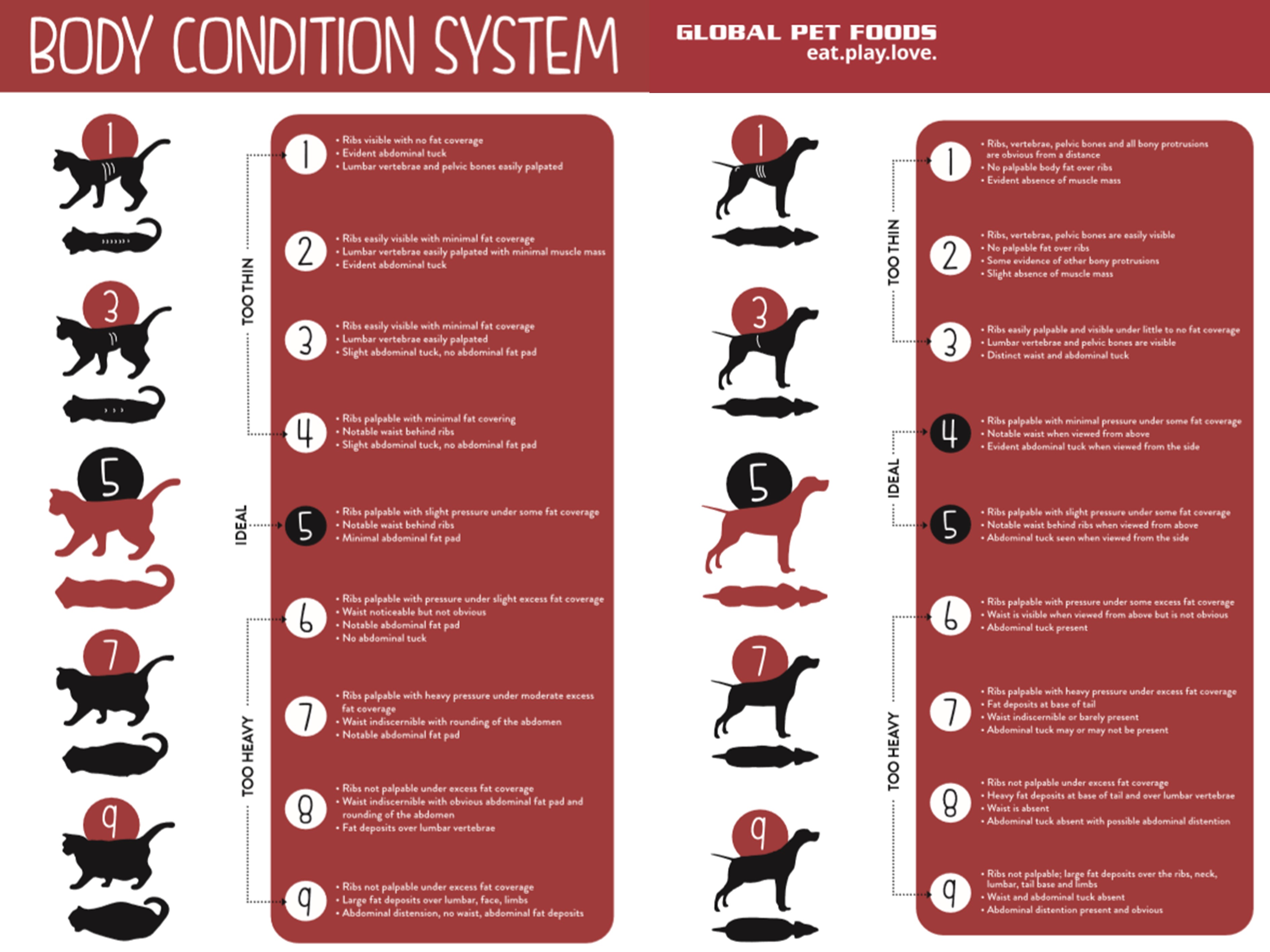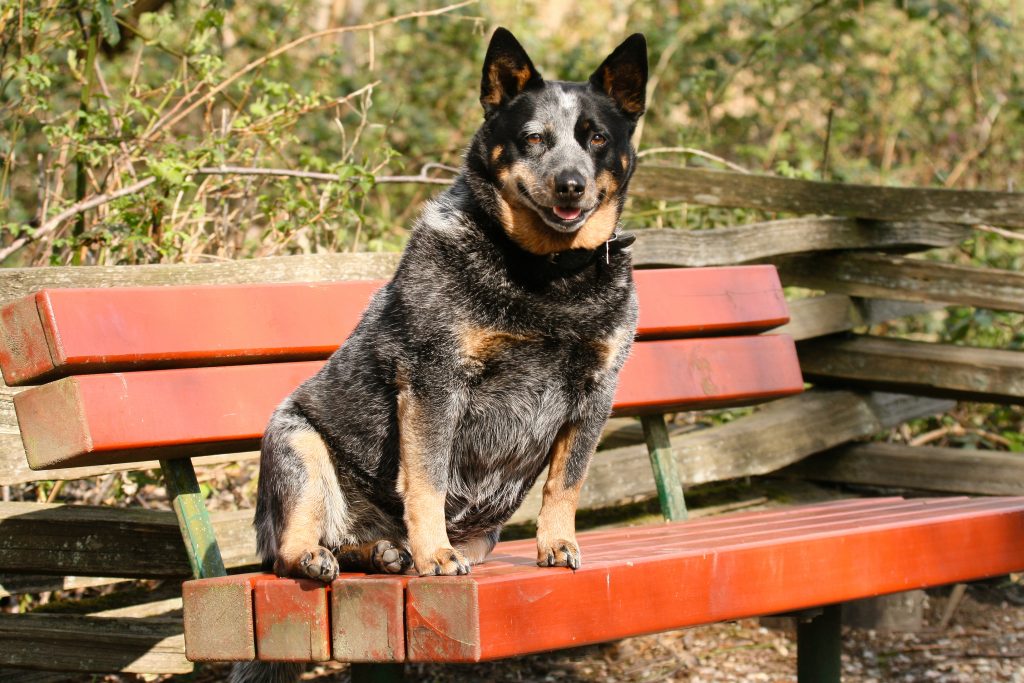Obesity is one of the most common health concerns for dogs and cats nationwide. There are many factors that contribute to excess weight gain in pets, but in the end, it comes down to calories in vs calories out, pets eating too much and exercising too little. The most prominent concern with obesity is the numerous health problems for which obesity is a precursor. Orthopedic disease is the biggest risk for overweight canines, whereas diabetes is the biggest risk for overweight felines. In addition to these, obese pets are also at higher risk for urinary tract disease, dermatitis, oral disease, pancreatitis, respiratory complications and renal disease.
Preventing obesity by closely monitoring body condition and feeding only as much as is required by the pet is extremely important. Note that feeding directions on pet food packaging is only a guideline and some dogs may require less than the recommended daily amount. Another thing to be aware of is that most household pets do not fit into the “active” or “highly active” category. We must be realistic about the exercise our pets are doing. Exclusively indoor cats do not tend to engage in intense activity. Dogs that go for a couple walks a day and perhaps to obedience or agility class once per week are considered moderately active. We also must be aware of the condition our pets are in. The majority (60-70%) of owners with overweight pets underestimate the body condition score of their pets. This means they score them as less overweight than they really are. Learning how to properly body score and being honest about your pet is imperative to their health. Feeding programs should also be regularly evaluated and adjusted. Pets may become less active as they get older, or during certain times of year, and food should be reduced accordingly. Unfortunately, in many cases, weight gain is not monitored closely enough, and feeding programs are not adjusted regularly. It is therefore important to know how to create an effective weight loss plan.
Simply switching to a weight management food is not always the answer. We have to pay close attention to the calories and where they are coming from. Some weight management diets are lower in fat and/or protein but not lower in calories. These diets provide a higher proportion of calories from carbohydrates, which is not beneficial for weight loss. A diet that is higher in protein and fat is advantageous for weight loss.
If you would like to learn how to create an effective weight loss plan for you pet, continue reading.
Creating a Weigh Loss Plan
Step 1: Body Condition Scoring
Accurately body score the pet and decide how much weight they need to lose. Every increment above “ideal” on the body condition score (BCS) scale accounts for 10-15% additional body weight due to excess fat deposition. Below is the 1-9 Body Condition system. This is the most accurate BCS system.

Example: We have a female Rottweiler that weighs 50kg. We assess her body condition and rate her a 7 on the BCS scale (5 is ideal). This means she needs to lose 20-30% of her body weight, which is 10-15kg. Based on her size, we estimate her ideal weight to be 40kg, so she needs to lose 10kg.
Step 2: Diet History and Adjustment
Catalogue daily food intake and calculate total calories consumed. This includes meals, treats, chews, table scraps and anything else the pet eats. Based on calories consumed and weight loss goal, decide on the level of caloric restriction. Calories can be reduced by 10-40% depending on the weight loss goal. Larger pets and pets with more weight to lose can tolerate more aggressive calorie reductions than small pets with less weight to lose.
Example: Our female Rottweiler needs to lose 10kg (20% of BW). She is consuming 4 cups of food (a total of 1620 calories) per day, plus 1 large dental chew (140 calories) per day. She is consuming a total of 1760 calories per day. We decide we want to reduce her caloric intake by 30% since she is a large dog with quite a few kgs to lose. We decide to reduce her food to the recommended amount for a less active 40kg dog, which is 2 ¾ cups according to the guideline on the package. We want to continue giving her one dental chew daily. This brings her calorie intake to a total of 1254 calories per day. This is approximately 29% calorie reduction. We did not need to make any big changes to her diet; she is eating the same food, just less of it.
Step 3: Exercise
Catalogue daily exercise and decide, based on the ability of the dog and the household, how to implement extra physical activity.
Example: We take our female Rottweiler for a 30 to 45-minute walk twice a day and we go to obedience class once per week. She is young, with no mobility restrictions, so we decide to replace one of her walks with a 1-1 ½ hour visit to an off-leash dog park where she can run.
Step 4: Re-evaluation & Adjustment
Every 2 weeks or so, the plan should be re-evaluated and adjusted if needed. Weight loss should progress at a rate of approximately 1-2% of body weight per week. For larger dogs with more weight to lose, a steep calorie reduction could result in quicker weight loss at the beginning of the program. If at any point in the program there is no weight loss observed for more than 2 weeks, the program should be adjusted by further reducing calories or increasing exercise.
Example: We should expect our rottweiler to weigh in at approximately 48-49kg after the first two weeks of the program, and the program should continue for 10-20 weeks until desired body weight is reached. At her first weigh in, she has dropped to 47kg. The program is working, so we continue! After 14 weeks, she weighs in at the goal weight of 40kg.
Step 5: Weight Maintenance
Once ideal body weight is reached, it must be maintained. The weight loss program should be continued after the ideal weight is achieved. If weight loss continues beyond the desired weight goal, calorie intake should be increased slightly until desired weight is maintained. Calories required for maintenance might be slightly higher than were required for weight loss. This maintenance step entails regular monitoring and adjustment.
Example: Our rottweiler has reached the goal weight of 40kg. We assess her body condition and are satisfied that she has reached a body condition score of 5 – the ideal score. We continue the same program for two more weeks, and at the next weigh-in, she is still at 40kg, so we will continue the same program to maintain her here. We continue to regularly weigh her and evaluate her body condition and make adjustments whenever necessary. With continued assessment, we should successfully maintain ideal body condition for the rest of her life.
For more information or for assistance creating a weight loss plan for your pet, visit your local Global Pet Foods store or submit a question or comment through our contact page.












